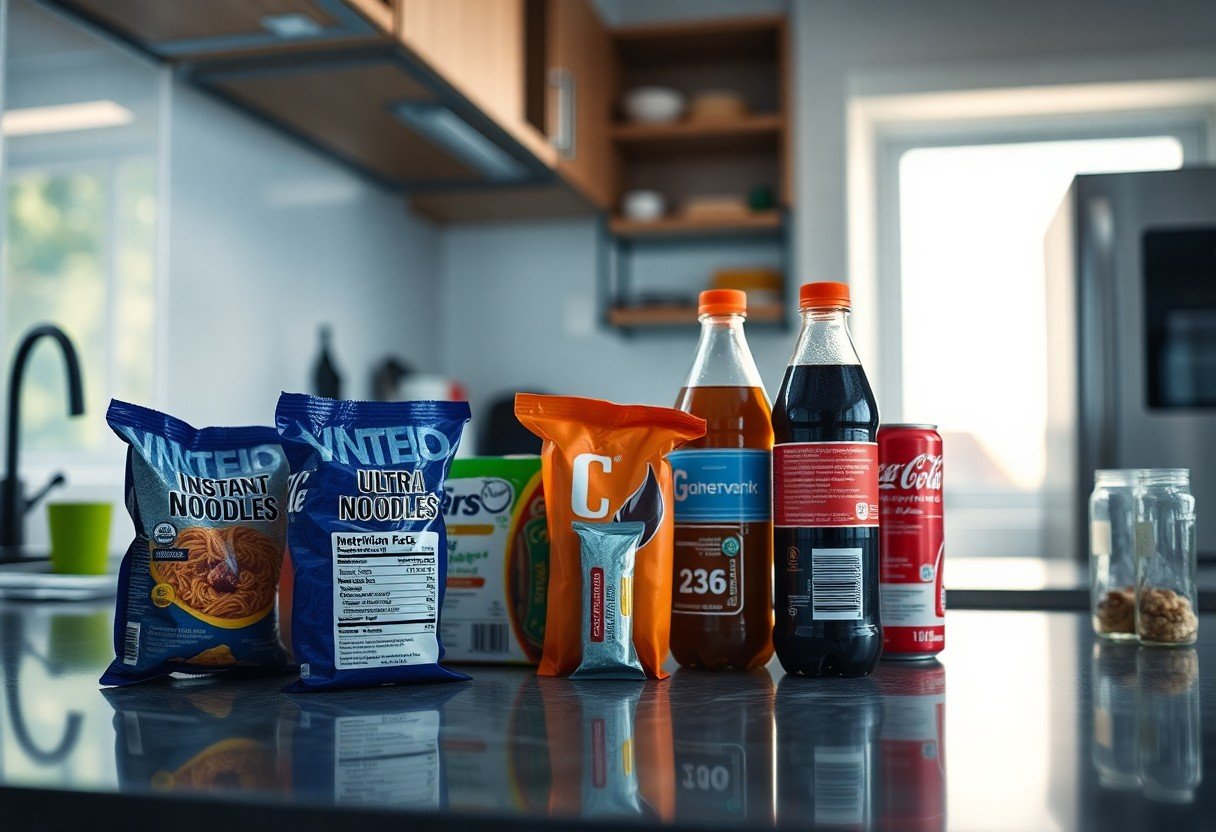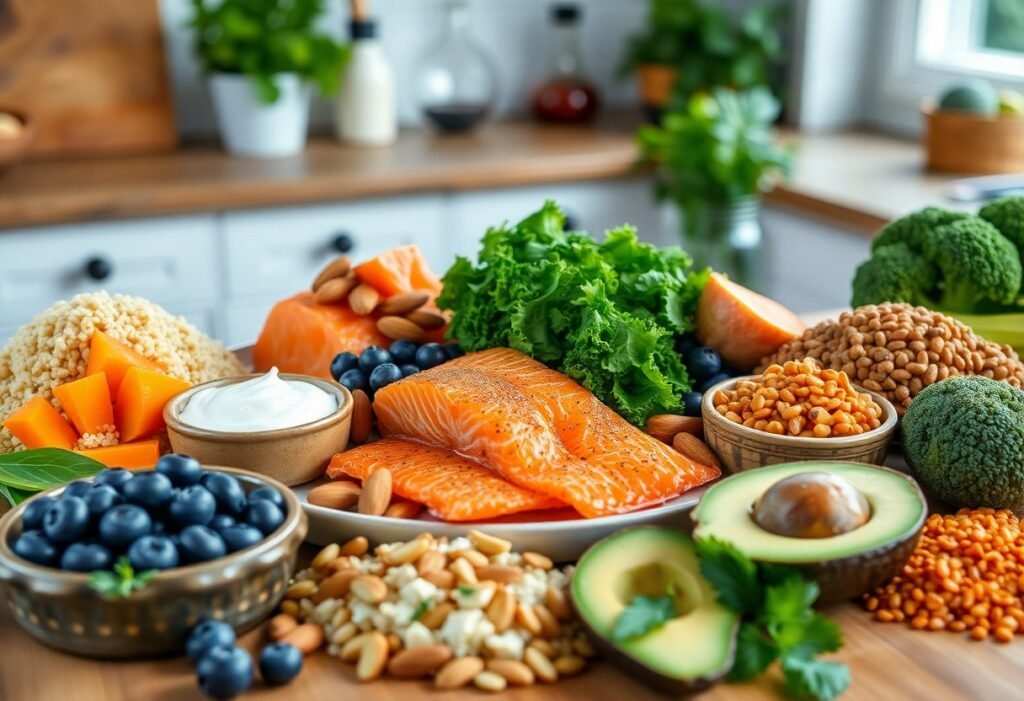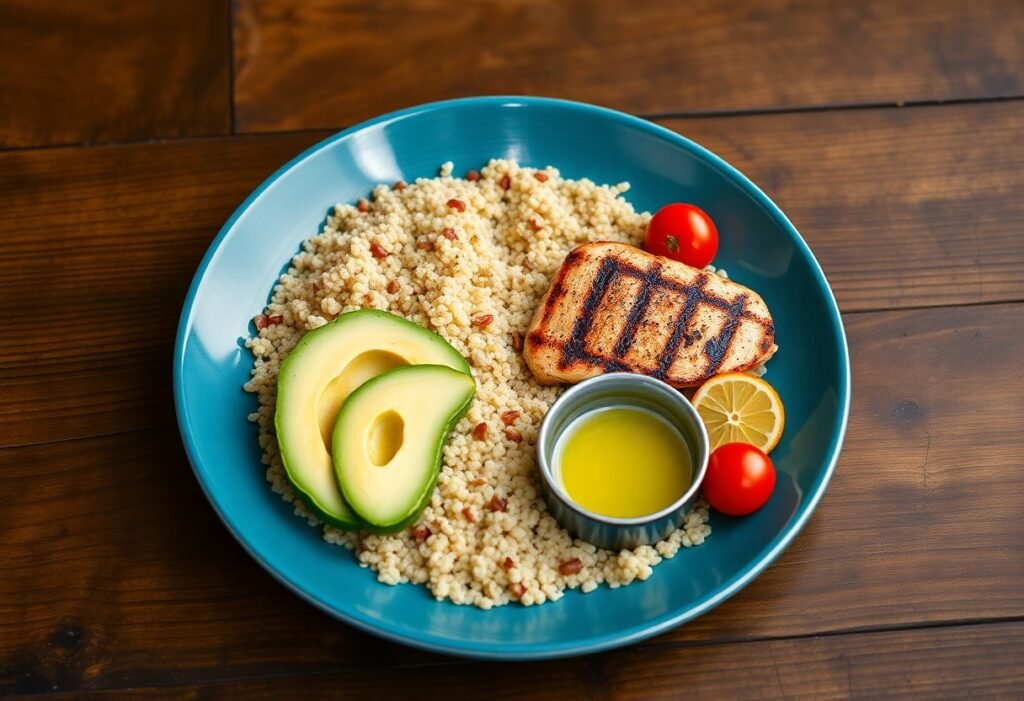Nutrition plays a pivotal role in your health, and understanding the impact of ultra-processed foods is crucial. Recent U.S. data highlights a concerning trend: over 60% of your daily caloric intake may come from these food products, often linked to negative health outcomes such as obesity and heart disease. However, awareness of these foods can empower you to make healthier choices, steering your diet toward whole, less-processed options that promote your well-being.
Key Takeaways:
- Ultra-processed foods contribute significantly to the overall caloric intake and have been linked to rising obesity rates in the U.S.
- Recent data indicates that a large percentage of American adults and children consume ultra-processed foods daily, impacting overall health outcomes.
- Increased consumption of ultra-processed foods is associated with higher risks of chronic diseases, including heart disease and diabetes.
Understanding Ultra-Processed Foods
Definition of Ultra-Processed Foods
Ultra-processed foods are products made from industrial ingredients that are not typically found in a home kitchen. These foods often contain additives such as sweeteners, preservatives, colorings, and flavorings, which enhance their appeal and prolong their shelf life. You can identify them by their lengthy ingredient lists, often filled with synthetic substances.
Common Examples of Ultra-Processed Foods
Some common examples of ultra-processed foods include sugary beverages, instant noodles, packaged snacks, and ready-to-eat meals. Fast food items, processed meats, and breakfast cereals are also key contributors to the ultra-processed category. These foods are often marketed for convenience and taste rather than nutrition.
In your daily life, products like potato chips, energy bars, and sodas are prime examples. Many frozen dinners fall into this category, offering quick meal solutions but often lacking vital nutrients. Snack cakes and flavored yogurt varieties are frequently laden with sugar and artificial ingredients, making it easy to overconsume while undernourishing yourself.
Nutritional Profile of Ultra-Processed Foods
The nutritional profile of ultra-processed foods typically features high levels of added sugars, unhealthy fats, and sodium. They often offer minimal vitamins, minerals, and fiber, which are vital for balanced health. Consequently, your diet may become unbalanced if these foods dominate your meals.
Studies show that consumption of ultra-processed foods can lead to deficiencies in vital nutrients. Over time, a diet rich in these products may result in inadequate intake of fiber and vital nutrients, contributing to poor overall health. This imbalance can cause you to feel hungry soon after eating as these foods often lack the necessary components to promote satiety.
Health Risks Associated with Consumption
Regular consumption of ultra-processed foods is linked to several health risks, including obesity, heart disease, and type 2 diabetes. Their ingredients can promote inflammation and negatively impact your gut health, leading to a range of metabolic disorders.
Research indicates that a diet high in these foods correlates with an increased risk of chronic diseases. For instance, a study from the American Journal of Clinical Nutrition found that individuals consuming more than 20% of their daily calories from ultra-processed foods had a greater likelihood of developing cardiovascular issues. This trend highlights the significant consequences of regularly opting for convenience over nutritional quality in your food choices.
The Rise of Ultra-Processed Foods in the U.S.
Historical Trends in Food Processing
Over the last century, food processing has evolved significantly, starting from simple preservation methods to the development of complex manufacturing techniques. The 1950s and 1960s marked the rise of convenience foods, largely driven by changing lifestyles and an increase in household incomes. As consumer demand for quick and easy meals grew, companies began to innovate, leading to a surge in the production of ultra-processed foods laden with additives and preservatives. This shift transformed eating habits, contributing to a growing reliance on these highly processed products.
Current Statistics on Ultra-Processed Foods Consumption
Today, ultra-processed foods make up approximately 60% of the total energy intake in the American diet. Recent surveys indicate that the average American consumes nearly 300 calories per day from these products, highlighting the significant role they play in daily nutrition. The prevalence of ultra-processed foods reaches across various age groups and demographics, showcasing their widespread accessibility and appeal.
Research indicates that the consumption of ultra-processed foods has risen alarmingly over the past few decades. A key study showed that in the 1970s, only about 30% of the diet consisted of ultra-processed items, a stark increase that underscores how ingrained these foods have become. This trend reflects a shift away from whole, minimally processed options, with many relying on ready-to-eat meals and snacks, leading to dietary imbalances and related health issues.
Demographic Factors Influencing Consumption
Consumption of ultra-processed foods varies significantly across different demographic segments. Factors such as age, income levels, and education play vital roles in determining dietary choices. For example, younger populations and those with lower income levels tend to consume more ultra-processed products due to their affordability and convenience. This pattern exhibits a concerning correlation with overall health disparities.
Various demographic factors contribute to the growing consumption of ultra-processed foods. For instance, individuals with lower levels of education may lack nutritional awareness, leading to higher reliance on these convenient options. Additionally, urban areas often have greater access to these products, reinforcing consumption patterns. Age plays a role too, as younger consumers are more likely to favor ready-to-eat meals. This illustrates the intersection of social and economic factors that shape dietary habits.
- age
- income levels
- education
- nutrition awareness
- urban accessibility
This growing reliance on ultra-processed foods raises significant public health concerns, pointing to the necessity for increased awareness and education.

The Impact of Ultra-Processed Foods on Health
Relationship between Ultra-Processed Foods and Obesity
Your consumption of ultra-processed foods is directly linked to the rising obesity rates. These foods are often high in calories, sugar, and unhealthy fats, making them more likely to contribute to weight gain compared to whole foods. Research suggests that individuals who consume a diet rich in these products exhibit a greater risk of developing obesity-related health issues.
Effects on Cardiovascular Health
Ultra-processed foods negatively impact your cardiovascular health by elevating blood pressure and cholesterol levels. This is due to their high content of trans fats and added sugars, which can lead to plaque buildup in the arteries, increasing your risk of heart disease.
Studies show a significant correlation between the intake of ultra-processed foods and cardiovascular events. For instance, a recent analysis found that individuals consuming more than 25% of their daily calories from ultra-processed foods had a higher risk of developing heart disease, showing a clear link between diet quality and heart health outcomes.
Links to Diabetes and Metabolic Syndrome
Research indicates that individuals with high ultra-processed food intake have a significantly greater chance of developing metabolic syndrome. For instance, one study found that each 10% increase in ultra-processed foods in your diet raises the likelihood of metabolic syndrome by 12%, emphasizing the need for dietary vigilance.
Influence on Mental Health and Cognitive Function

Regulatory and Policy Responses
Current Food Labeling Regulations
The existing food labeling regulations in the U.S. primarily focus on ingredients and nutritional information, yet they often fail to clearly differentiate between ultra-processed and minimally processed foods. Recent proposals aim to enhance transparency by potentially requiring manufacturers to disclose the extent of food processing, helping consumers make more informed choices. For more on food consumption trends, see How Much Ultra-Processed Food Are People Eating in ….
Initiatives to Promote Whole Foods
Several initiatives have emerged to encourage the consumption of whole foods, focusing on education and accessibility. For example, programs provide resources and incentives for farmers’ markets, promoting community-level engagement.
Such initiatives include meal planning workshops and cooking demonstrations, which show you how to prepare affordable meals with fresh ingredients. By fostering local gardens and partnerships with grocery stores, these programs aim to increase access to nutritious options, ultimately reducing your reliance on ultra-processed foods.
Public Health Campaigns
Public health campaigns play a key role in raising awareness about the risks associated with ultra-processed foods. These campaigns often highlight the connection between diet and chronic diseases, encouraging healthier eating habits.
Campaigns such as “Choose My Plate” and “Healthy People 2030” focus on educating you about nutritional guidelines and the value of whole foods. They use various platforms, including social media and community outreach, aiming to shift public perception about food choices and promoting dietary changes that prioritize whole, unprocessed foods for better health outcomes.

Consumer Awareness and Behavior
Trends in Consumer Preferences
You may notice a growing shift towards whole foods and alternatives to ultra-processed options. Recent surveys show that nearly 40% of consumers actively seek to reduce their intake of processed foods, indicating a heightened awareness of nutrition. This trend reflects an increasing desire for transparency in food labeling and a preference for natural ingredients, leading many brands to reformulate their products for healthier appeal.
Education and Awareness Programs
Your understanding of nutrition is crucial, which is why many communities are launching education programs focused on the impact of ultra-processed foods. Initiatives often include workshops, cooking classes, and resources aimed at informing the public about healthy eating. These programs encourage informed food choices and provide tools to make better decisions.
Such education and awareness programs have proven effective in altering consumer behavior significantly. For instance, community-based initiatives in urban areas have reported a 30% decrease in the consumption of ultra-processed foods among participants. Many programs utilize interactive methods, such as cooking demonstrations and nutrition seminars, to engage individuals and families directly, fostering a deeper understanding of labels, ingredients, and the long-term health implications of dietary choices.
Barriers to Reducing Ultra-Processed Foods Intake
Despite increased awareness, several barriers hinder your ability to reduce consumption of ultra-processed foods. Issues such as accessibility, affordability, and time constraints can all affect your food choices. Many individuals find it challenging to prioritize healthier options when faced with a busy lifestyle and limited budgets.
The barriers to reducing ultra-processed foods intake are multifaceted. For many, convenience outweighs health considerations when navigating a hectic schedule. Additionally, the lower price point of processed foods makes them more appealing for budget-conscious consumers. Data indicates that families with limited resources often rely on these foods, which can lead to poor dietary habits. Awareness of nutrition alone isn’t enough; systemic changes are needed to make healthier options more accessible and affordable for everyone.
Alternatives to Ultra-Processed Foods
Nutrient-Dense Whole Foods
Consider incorporating nutrient-dense whole foods into your diet to improve your health. Foods like leafy greens, lean proteins, whole grains, and legumes are packed with vital vitamins and minerals. For example, quinoa provides complete protein and fiber, while spinach offers iron and calcium. These foods not only nourish your body but also help you feel full and satisfied, reducing cravings for ultra-processed items.
Meal Preparation Strategies
Adopting effective meal preparation strategies can simplify your transition away from ultra-processed foods. Planning your meals in advance allows you to control ingredients and serving sizes, ultimately fostering healthier eating habits. Batch cooking and portioning meals can save time while ensuring you have nutritious options readily available.
Investing time in meal prep can lead to significant savings on both your grocery bill and dining out expenses. Start by dedicating a few hours on weekends to prepare grains, proteins, and vegetables. For example, cooking a large pot of brown rice, grilling chicken breasts, and roasting seasonal vegetables can provide a week’s worth of nutritious meals. Utilizing storage containers ensures that you have healthy options at your fingertips, making it less likely you’ll reach for ultra-processed snacks.
Building Healthy Grocery Lists
Creating healthy grocery lists is vital for making informed food choices. Focus on whole, unprocessed foods by organizing your list into categories such as fruits, vegetables, proteins, and grains. This approach helps you stay on track while shopping and reduces the temptation to add unhealthy items to your cart.
When building your grocery list, aim to include a variety of seasonal produce to maximize nutrient intake. Check your pantry first to avoid duplicates and strategically plan meals around items you already have. This method not only minimizes waste but also encourages you to experiment with different ingredients, ultimately leading to a more diverse and wholesome diet that supports your health goals.
To wrap up
The latest U.S. data highlights the growing prevalence of ultra-processed foods in your diet, revealing significant implications for your health. By understanding the impact of these foods on nutrition and well-being, you can make informed choices that steer you towards a more balanced diet. As you assess your eating habits, prioritizing whole foods over ultra-processed options might significantly enhance your overall health outcomes.
FAQ
Q: What are ultra-processed foods?
A: Ultra-processed foods are products made with industrial ingredients and additives, often containing little to no whole foods. They typically include sugary drinks, packaged snacks, instant noodles, reconstituted meat products, and many ready-to-eat meals.
Q: What are the health effects of consuming ultra-processed foods?
A: Consumption of ultra-processed foods has been linked to various health issues, including obesity, heart disease, diabetes, and certain cancers due to high sugar, salt, and unhealthy fat content.
Q: How prevalent are ultra-processed foods in the average American diet?
A: Recent U.S. data indicates that ultra-processed foods account for about 60-70% of the daily caloric intake for many Americans, highlighting a significant reliance on these foods in the diet.
Q: How can one identify ultra-processed foods?
A: Ultra-processed foods can often be identified by their long ingredient lists featuring additives like preservatives, artificial flavors, and sweeteners, often lacking recognizable whole food ingredients.
Q: What steps can be taken to reduce the consumption of ultra-processed foods?
A: To reduce consumption, focus on whole foods like fruits, vegetables, whole grains, and unprocessed proteins. Meal prepping, cooking at home, and reading labels can also help avoid ultra-processed options.










